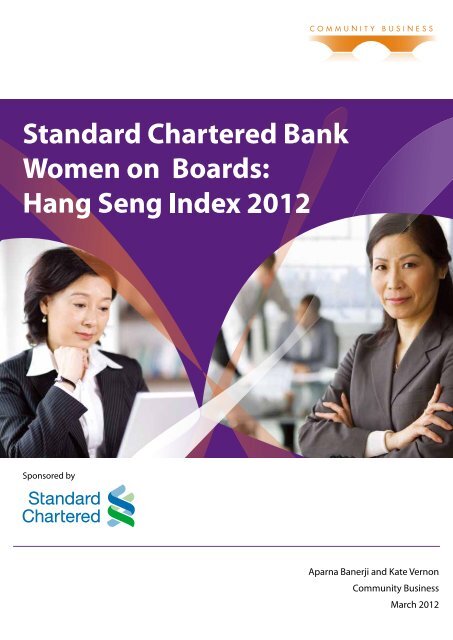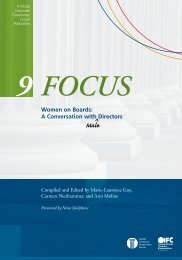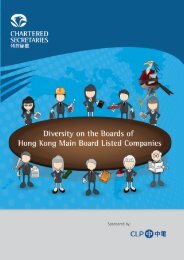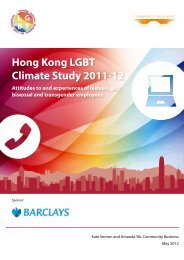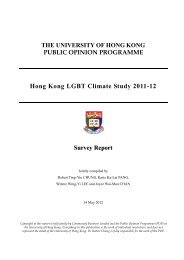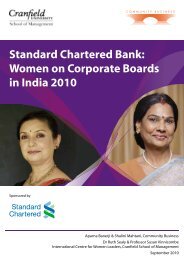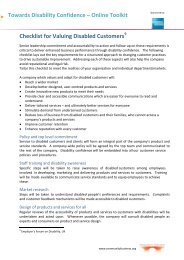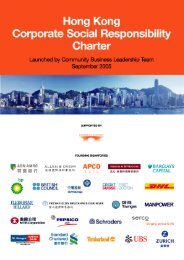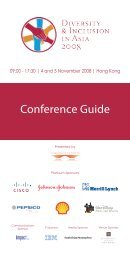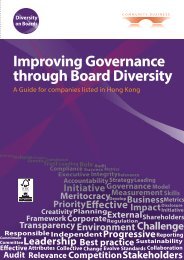Hang Seng Index 2012 - Community Business
Hang Seng Index 2012 - Community Business
Hang Seng Index 2012 - Community Business
- No tags were found...
Create successful ePaper yourself
Turn your PDF publications into a flip-book with our unique Google optimized e-Paper software.
ACKNOWLEDGEMENTS<strong>Community</strong> <strong>Business</strong> thanks Standard Chartered Bank for their sponsorship of thisStandard Chartered Bank Women on Boards: <strong>Hang</strong> <strong>Seng</strong> <strong>Index</strong> <strong>2012</strong> report, the secondof its kind for Hong Kong.In addition <strong>Community</strong> <strong>Business</strong> acknowledges the contribution of David Webb whoprovided access to his proprietary database of information on companies listed on the <strong>Hang</strong><strong>Seng</strong> <strong>Index</strong>. This was a valuable tool for validating and updating information obtained fromthe public domain.<strong>Community</strong> <strong>Business</strong> thanks William Du for reviewing the data and the following peoplefor reviewing the entire report: Shalini Mahtani, Founder of <strong>Community</strong> <strong>Business</strong>; RosieHalfhead, Managing Director, RHC Asia; and Jamie Allen and Sharmila Gopinath of AsianCorporate Governance Association. Thank you to Sandy Chan for managing the design andproduction.DISCLAIMERAll information in this document is provided for general information only and is not in the nature of advice. It shouldnot be relied upon for any purpose and <strong>Community</strong> <strong>Business</strong> Limited (CBL) makes no warranty or representationand gives no assurance as to its accuracy, completeness or suitability for any purpose. Inclusion of informationabout a company, programme or individual in this publication does not indicate CBL’s endorsement. Where cited,you should refer to the primary sources for more information. This report does not necessarily reflect the viewsof CBL member companies or the sponsors of this report. CBL reserves the right to make alterations to any ofits documents without notice. Reproduction and dissemination of this document is permitted provided that thedocument is unaltered and ownership is acknowledged. Express permission of the Board of Directors of CBL isrequired for use of this document (in whole or in part) if such use will generate income for the licensee.The <strong>Hang</strong> <strong>Seng</strong> <strong>Index</strong> is published and compiled by <strong>Hang</strong> <strong>Seng</strong> <strong>Index</strong>es Company Limited. The mark and name<strong>Hang</strong> <strong>Seng</strong> <strong>Index</strong> is proprietary to <strong>Hang</strong> <strong>Seng</strong> Data Services Limited. No responsibility or liability is accepted by<strong>Hang</strong> <strong>Seng</strong> <strong>Index</strong>es Company Limited or <strong>Hang</strong> <strong>Seng</strong> Data Services Limited in respect of the use of or referenceto the <strong>Hang</strong> <strong>Seng</strong> <strong>Index</strong> in this document. Readers of this report should note that this report is not authorised orendorsed by <strong>Hang</strong> <strong>Seng</strong> <strong>Index</strong>es Company Limited or <strong>Hang</strong> <strong>Seng</strong> Data Services Limited.Printed on environmentalfriendly paper© <strong>Community</strong> <strong>Business</strong> Limited <strong>2012</strong>4www.communitybusiness.org
CONTENTSFOREWORD 2EXECUTIVE SUMMARY 4WOMEN ON BOARDS LEAGUE TABLE: HSI <strong>2012</strong> 5INTRODUCTION 8FINDINGS 101. General Composition of HSI Boards 102. Profile of HSI Companies 103. Top Performing Companies on HSI 114. HSI Companies with Women on Boards 115. Representation of Women on Boards of HSI Companies 126. Female Executive Directors in HSI Companies 137. Women Holding Multiple Directorships in HSI Companies 148. Age and Tenure of Female Directors in HSI Companies 159. New HSI Director Appointments in 2011 15CONCLUSION 17REFERENCES 18www.communitybusiness.org 1
WOMEN ON BOARDSLEAGUE TABLE:HSI <strong>2012</strong>www.communitybusiness.org 5
IntroductionINTRODUCTIONBackground<strong>Community</strong> <strong>Business</strong> has long championed the role of women in the corporate arena in Asia. From the publicationof one of its earliest reports ‘Women Leaders in Hong Kong’ 5 to the more recent launch of its ‘Gender DiversityBenchmark for Asia 2011’, 6 <strong>Community</strong> <strong>Business</strong> has presented the case that women have an essential contributionto make to business but remain under-represented at senior levels of their organisations.The debate about women on boards is heating up as an increasing number of governments and companiesrecognise the link between greater board diversity and improved corporate governance and enhanced businessperformance. A growing body of research proves that diversity of experience and views creates better decisionmaking,which equally applies in a company’s boardroom. Global research from McKinsey, Bain & Companyand Catalyst demonstrate that when there are more women in senior management and the boardroom, thosecompanies produce better financial results for shareholders than their less diverse comparators. This is aside fromthe obvious benefit of a company reflecting its own customer base. Half or more of purchasing decisions in mostcountries are currently made by women, so it makes good business sense to include more women in top corporatemanagement roles. 7A number of reports and studies have emerged highlighting the disparities between countries and sectors aroundthe world. In September 2009, <strong>Community</strong> <strong>Business</strong> partnered with Cranfield School of Management in the UK toproduce the inaugural Women on Boards: <strong>Hang</strong> <strong>Seng</strong> <strong>Index</strong> 2009 report, also sponsored by Standard CharteredBank. This was followed in September 2010 by the publication of the Standard Chartered Bank: Women onCorporate Boards India 2010 report. Both these pieces of work have been widely referenced as a means to initiatedebate around the benefits of greater gender diversity on boards in Asia as well as a wider discussion about theadvancement of women in the region. This Standard Chartered Bank Women on Boards: <strong>Hang</strong> <strong>Seng</strong> <strong>Index</strong> <strong>2012</strong>report provides a timely update of the representation of women on the boards of Hong Kong’s leading companies.Gender Diversity of Boards - International DevelopmentsThe call to increase gender diversity on boards is not a new business issue, but approaches on how to achieve itdiffer significantly. They include coercive measures via regulation, voluntary codes of practice, as well as moremarket-driven collaborative efforts.Worthy of particular mention is Lord Davies’ report ‘Women on Boards’ published in February 2011 in the UK whichsets out a series of recommendations to increase the number of women on company boards. The study suggeststhat listed companies in the UK should publish the number of women sitting on their boards and working in theirorganisations. It also recommends that businesses in FTSE 350 companies should set their own targets for increasingfemale representation on their boards by 2015. Lord Davies suggests that the FTSE100 should challenge themselvesto increase the proportion of female directors on their boards to 25% by 2015. 8Other examples include:· In February 2002, the Norwegian government gave a deadline of July 2005 for privately listed companies toraise the proportion of women on their boards to 40%. 9· Spain passed a gender equality law in 2007 obliging public companies and IBEX-quoted firms with more than250 employees to reach a minimum of 40% representation of men and women on boards by 2015. 10· France has passed a bill applying a 40% quota for female directors by 2016. 11· In June 2011, Belgium proposed legislation for a one-third quota of women on boards. The law is still to beapproved by the Senate but provides for the quota system to come into force from <strong>2012</strong>. Under the new rules,each time a director leaves, he or she is to be replaced by a woman until the quota is fulfilled. 12· Since July 2010, Australia requires all listed companies to disclose information about the proportion of womenon the board and to provide progress reports on gender objectives. 13· Singapore and Malaysia propose incorporating specific references to gender diversity in their code of conductfor listed companies. In 2011, Malaysia set a target for 30% representation of women.8www.communitybusiness.org
IntroductionCorporate Governance in Hong Kong 14In the wake of the recent global economic crisis, there has been much debate about the need for tightercorporate governance standards – not just globally but also in Hong Kong. Indeed there have been many recentdevelopments in Hong Kong, including a review of the Corporate Governance Code and associated Listing Rulesand the introduction of the Securities and Futures (Amendment) Bill 2011.The Hong Kong Stock Exchange Listing Rules split corporate governance requirements as follows:1. Listing Rules where compliance is mandatory.2. Code on Corporate Governance Practices• Code provisions on a comply or explain basis• Recommended best practices (RBPs) which are voluntaryThe recent changes are wide reaching, although most are changes to the Code and involve upgrading RBPs to Codeprovisions. There has been a particular focus on increasing the responsibility and accountability of non-executivedirectors. However there are a number of changes that have a particular impact on the composition of boards.These include:• Number of Independent Non-Executive Directors (INEDs). Previously the Code provision highlighted that everyboard should have at least three INEDs. This has now been updated to state that INEDs should constitute atleast one third of the board (effective 31 December <strong>2012</strong> for existing issuers).• Remuneration Committee. Previously a Code provision, from, April <strong>2012</strong>, a Remuneration Committee isobligatory and it is stated that the majority of members (including the chairman) must be INEDs.• Nominations Commmittee. Upgraded from a RBP to a Code provision, all companies should have aNominations Committee. It is further stipulated that this should be made up of a majority of INEDs and bechaired by an INED or board chairman. A key function of this Committee is to review the size, structure andcomposition of the board (including selection of INEDs).As the composition of boards becomes subject to greater scrutiny and companies in Hong Kong are called to makechanges to their boards, it opens up the possibility for greater debate around the diversity of boards. In particularthe value diversity of all kinds brings to independence and the quality of decision-making. Considering the genderdiversity of boards is clearly central to this. The timing of the release of this report which includes the Women onBoards League Table: HSI <strong>2012</strong> is all the more relevant in this context.MethodologyThis research looks at the representation of women on the boards of Hong Kong’s leading companies, as listed onthe <strong>Hang</strong> <strong>Seng</strong> <strong>Index</strong> (HSI).The HSI is a freefloat-adjusted market capitalisation-weighted stock market index in Hong Kong. It includes thelargest and most liquid stocks listed on the Main Board of the Stock Exchange of Hong Kong. It is used to recordand monitor daily changes of the largest companies of the Hong Kong stock market and is the main indicator ofthe overall market performance in Hong Kong. As of 10 January <strong>2012</strong>, there were 48 HSI constituent stocks in total.These companies formed the focus of this study.The methodology for this research was modelled on that of the Women on Boards: <strong>Hang</strong> <strong>Seng</strong> <strong>Index</strong> 2009 report.Data was collated primarily from publicly available sources. These included corporate websites, annual reports andinternet searches. The data was also cross-checked against David Webb’s (of Webb-site.com) proprietary database, 15particularly with regards to: age of directors, tenure of directors and new appointments. The data was collected by<strong>Community</strong> <strong>Business</strong> and entered into spreadsheets with a cut off date of 10 January <strong>2012</strong>. It should be noted thatthe data does not reflect changes – either pre-announced or otherwise, after that date.www.communitybusiness.org 9
FINDINGSFINDINGS1. GENERAL COMPOSITION OF HSI BOARDSTo set the context for the examination of the representation of women on boards in Hong Kong, Table 1 shows theoverall composition of the boards of the <strong>Hang</strong> <strong>Seng</strong> <strong>Index</strong> (HSI). It looks at the split between executive and nonexecutiveroles as well as the proportion of independent non-executive directorships. The equivalent numbers for2009 are also shown by way of comparison.Table 1: Composition of Boards on HSIHSI Companies<strong>2012</strong>HSI Companies2009Executive Directors 223 (35.2%) 214 (36.6%)Non-Executive Directors (NEDs) 411 (64.8%) 371 (63.4%)Total Directorships 634 585Independent NEDs 247 (60.1%) 221(59.6%)The number of companies listed on the HSI has increased by six, from 42 companies in 2009 to 48 companies in<strong>2012</strong>. One company from 2009 is no longer listed (Foxconn International Holdings Ltd) which means seven newcompanies have been added to the index. These are highlighted in purple in the Women on Boards LeagueTable: HSI <strong>2012</strong> on pages 6 and 7. The increase in total number of directorships from 585 to 634 (8%) reflects theadditional companies added to the list. Despite these additions there has been no significant change in the overallcomposition of boards in terms of the split between executive and non-executive directors and the percentage ofdirectors who are deemed to be independent.2. PROFILE OF HSI COMPANIESThe HSI is broken into four sub-indices: the <strong>Hang</strong> <strong>Seng</strong> Commerce and Industry Sub-<strong>Index</strong>, the <strong>Hang</strong> <strong>Seng</strong> FinanceSub-<strong>Index</strong>, the <strong>Hang</strong> <strong>Seng</strong> Properties Sub-<strong>Index</strong> and the <strong>Hang</strong> <strong>Seng</strong> Utilities Sub-<strong>Index</strong>. The distribution of the 48companies across these sub-indexes is shown in Chart 1. Compared to 2009, there are four additional companiesin the Commerce and Industry Sub-<strong>Index</strong>, and one additional company in each of the Finance Sub-<strong>Index</strong> andProperties Sub-<strong>Index</strong>.Chart 1: Distribution of HSI Companies by Sub-<strong>Index</strong>Utilities8%Properties15%Commerce and IndustryFinancePropertiesUtilitiesFinance25%Commerceand Industry52%10www.communitybusiness.org
FINDINGStruly reap the benefits of gender diversity. Until then, there is danger that the individual woman will assimilate withher male peers to the extent that the benefits of diversity are not fully realised. Using 15% as a barometer therefore,only 12 companies or one-quarter of those listed on this HSI would appear to be gaining from the gender diversityof their boards.What is of concern is that the number of companies with no female representation on their boards has increasedfrom 14 companies (33.3%) to 20 companies (41.7%).The number of companies with female executive directors has also dropped from 13 to 12 representing just 25.0%.The representation of female executive directors is important and is examined further in Section 6.5. REPRESENTATION OF WOMEN ON BOARDS OF HSI COMPANIESTable 3: Representation of Women on Boards of HSI CompaniesKey Gender Diversity Numbers <strong>2012</strong> 2009No. % No. %Total number of directorships 634 585Total female held directorships 57 9.0% 52 8.9%Total number of executive directorships 223 214Female executive directorships 15 6.7% 15 7.0%Total number of non-executive directorships 411 371Female non-executive directorships 42 10.2% 37 9.9%Number of women holding HSI directorships 50 47As Table 3 indicates, out of a total of 634 directorships on HSI corporate boards only 57 directorships are held bywomen. This gives an overall percentage of 9.0% and represents a nominal and disappointing improvement since2009. Whilst the total number of directorships has increased (due to the additional number of companies on theHSI) by 49, only 5 of these additional positions are held by women. 50 women hold these 57 directorship roles,representing an overall increase of only 3 women since 2009.Comparing this to international figures, it can be seen in Chart 2 that although this percentage is low, Hong Kongactually performs better than several countries in Asia, namely, India, 18 Singapore, 19 Malaysia 20 and Mainland China. 21However Hong Kong lags behind other markets – namely Australia, 22 UK, 23 US 24 and most notably, Norway. 25Chart 2: Percentage of Women on Boards - An International ComparisonNorway (2011)40.1%US (2011)UK (2011)Australia (2011)Hong Kong (<strong>2012</strong>)China (2011)Malaysia (2011)Singapore (2011)India (2010)16.1%15.0%10.9%9.0%8.1%7.8%6.9%5.3%0% 10% 20% 30% 40% 50%12www.communitybusiness.org
FINDINGS6. FEMALE EXECUTIVE DIRECTORS IN HSI COMPANIESIn examining the gender diversity of boards it is interesting to look at the number of executive directorships heldby women. In many respects this can be viewed as a true measure of gender diversity within an organisation, asit indicates that the company’s working environment is such that women have successfully risen up through theorganisation to reach board level. By contrast, appointing women to non-executive roles is sometimes easier to doand can be regarded as a quick fix to improving the gender diversity of boards. However, external appointments arealso often more susceptible to the vagaries of a subjective appointment process, with all the pitfalls of stereotypingand unconscious bias.Table 4: Representation of Female Executive Directors on HSI Boards<strong>2012</strong> 2009 Relative Increase orNo. % No. % Decrease Since 2009Total number of female directorships 57 9.0% 52 8.9% IncreaseFemale directorships that are executive 15 26.3% 15 28.8% DecreaseTotal number of executive directorships 223 214Executive directorships that are held by women 15 6.7% 15 7.0% DecreaseOf the total of 57 directorships held by women, 15 are executive director roles which represents 26.3%. Looking atthis as a percentage of the overall number of executive directorship roles which is 223, this represents just 6.7%.Given that the overall number of executive directorships has grown by 9 but the number of women has remainedstatic since 2009, both these figures represent an overall percentage decline.At the same time the number of companies with female executive directors has dropped (see Table 2). Onlytwelve of the 48 companies (25.0%) listed on the HSI now have female executive directors. The profile of these 12companies is shown in Table 5. The composition of this list has changed since 2009. There are two new companies,Industrial and Commercial Bank Ltd and Sino Land Company Ltd, whilst three of the original companies have losttheir female executive directors (China Construction Bank Corporation, COSCO Pacific Ltd and Li & Fung Ltd). Threeof the companies in this list have two female executive directors.Table 5: Profile of 12 Companies on HSI with Female Executive DirectorsRank Company % FemaleBoardTotalFemaleDirectorsFemaleExecutiveDirectorsSectorTotalBoard Size1 <strong>Hang</strong> <strong>Seng</strong> Bank Ltd 31.3% 5 1 Finance 164 China Resources Power Holdings21.4% 3 2 Utility 14Company Ltd6 Cheung Kong (Holdings) Ltd 20.0% 4 2 Property 207 China Life Insurance Company Ltd 18.2% 2 1 Bank 119 The Ping An Insurance (Group)16.7% 3 1 Bank 18Company of China Ltd11 Hutchison Whampoa Ltd 15.4% 2 1 Commerce 13& Industry11 China Mobile Ltd 15.4% 2 2 Commerce 13& Industry13 Industrial and Commercial Bank of 12.5% 2 1 Bank 16China Ltd18 Hendersen Land Development10.0% 2 1 Property 20Company Ltd19 Sino Land Company Ltd 9.1% 1 1 Property 1120 The Wharf (Holdings) Ltd 8.3% 1 1 Commerce 12& Industry27 Power Assests (previously HongkongElectric Holdings Ltd)6.3% 1 1 Utility 16www.communitybusiness.org 13
FINDINGSIt is interesting to note that 11 of the 12 companies who have female executive directors are ranked in the top 20of the Women on Boards League Table: HSI <strong>2012</strong>. This suggests that companies with female executive directorsare also more likely to have multiple female directors and a higher overall percentage of women on their board. Ashighlighted in the previous report, it is not possible to comment on the direction of causality – that is which camefirst, female executive directors or female board directors, but there does appear to be a link.Executive Roles Held by WomenThe 15 executive director roles are held by 14 different women, as listed in Table 6. Although the overall number ofwomen has not changed since 2009, there are some changes to the list, with three additional names, includingIP Alice MoLin ( 葉 慕 蓮 ) of Sino Land Company Ltd, WANG Lili ( 王 麗 麗 ) of Industrial and Commercial Bank of ChinaLtd and ZHOU Junqing ( 周 俊 卿 ) of China Resources Power Holdings Company Ltd.China Resources Power Holdings Company Ltd is the only company on the HSI with a female Chair, ZHOU Junqing( 周 俊 卿 ) and <strong>Hang</strong> <strong>Seng</strong> Bank Ltd continues to have the distinction of being the only company on the HSI with afemale CEO, LEUNG KO May Yee Margaret ( 梁 高 美 懿 ).Table 6: Executive Roles Held by WomenName Job Title CompanyCHOW WOO Mo Fong Susan( 周 胡 慕 芳 )Deputy Group Managing DirectorExecutive DirectorHutchison Whampoa LtdPower Assets(previously Hongkong Electric Holdings Ltd)FUNG LEE Woon King ( 馮 李 煥 琼 ) The Treasurer Hendersen Land Development Company LtdHUANG Wenlin ( 黃 文 林 ) Vice President China Mobile LtdIP Alice Mo Lin ( 葉 慕 蓮 ) Executive Director Sino Land Company LtdLEE Yuk Fong Doreen ( 李 玉 芳 ) Executive Director The Wharf (Holdings) LtdLEUNG KO May Yee Margaret Chief Executive Officer<strong>Hang</strong> <strong>Seng</strong> Bank Ltd( 梁 高 美 懿 )LIU Yingqi ( 劉 英 齊 ) Vice President China Life Insurance Company LtdPAU Yee Wan Ezra ( 鮑 綺 雲 ) Executive Director Cheung Kong (Holdings) LtdWANG Lili ( 王 麗 麗 ) Managing Director Industrial and Commercial Bank of China LtdWANG Liping ( 王 利 平 ) Senior Vice President The Ping An Insurance (Group) Company ofChina HLtdWANG Xiao Bin ( 王 小 彬 ) Chief Financial Officer China Resources Power Holdings CompanyLtdWOO Chia Ching Grace ( 吳 佳 慶 ) Executive Director Cheung Kong (Holdings) LtdXIN Fanfei ( 辛 凡 非 ) Vice President China Mobile LtdZHOU Junqing ( 周 俊 卿 ) Chair and Executive Director China Resources Power Holdings CompanyLtd7. WOMEN HOLDING MULTIPLE DIRECTORSHIPS IN HSI COMPANIES50 women hold 57 directorships on the HSI. This means some women hold more than one directorship. There hasbeen some debate about the pros and cons of corporate board members holding multiple directorships in variouscompanies and the academic research on this matter appears inconclusive.Table 7: Women Holding Multiple Directorships in HSI CompaniesNumber of Seats 1 seat 2 seats 3 seatsNumber of Women 45 (90.0%) 3 (6.0%) 2 (4.0%)Table 7 shows that within the HSI, by far the majority (90.0%) of women hold just one directorship. However, threewomen hold two directorships - FUNG Yuen Mei Anita ( 馮 婉 眉 ), CHA Laura May Lun ( 史 美 倫 ) and CHOW WOO MoFong Susan ( 周 胡 慕 芳 ). Mrs Chow’s situation is unusual in that she hold two executive directorships. Power Assets14www.communitybusiness.org
FINDINGS(previously Hong Kong Electric Holdings Ltd) and Hutchison Whampoa Ltd are both members of Cheung KongGroup. Two women have three directorships within the HSI – they are LEUNG KO May Yee Margaret ( 梁 高 美 懿 ) andFAN Hsu Lai Tai Rita ( 范 徐 麗 泰 ).8. AGE AND TENURE OF FEMALE DIRECTORS IN HSI COMPANIESIn examining the composition of boards it is interesting to look at the age and tenure of directors.Table 8: Age and Tenure on Boards<strong>2012</strong> Age Tenure on BoardAll EDs NEDs Average RangeMen 59.9 years 56.1 years 62.2 years 6.5 years 0 - 44 yearsWomen 57.3 years 57.6 years 56.8 years 4.8 years 0 - 35 yearsThe average age of male directors is 59.9 years and the age range is 29 to 87, with 14% of male directors being overthe age of 65. Looking at the same statistics for women, the average age of female directors is 57.3 years, the agerange is 42 to 73 and 12.2% of the women are over the age of 65.These numbers show that the women are on average two and a half years younger than the men holding boardpositions. This is a pattern that is generally seen internationally. 26 It is interesting to note too that the executive maledirectors are on average 6 years younger than the non-executive male directors. However, this does not seem to bereflected with the women. The average age of female non-executive directors is 56.8 years whilst the average age offemale executive director is slightly older at 57.6 years.There is increased interest in the tenure of directors and debate about whether term limits ought to be enforcedto prevent directors becoming too entrenched and distant from the interests they are meant to represent. HongKong’s own Code of Practice on Corporate Governance states that ‘non-executive directors should be appointed for aspecific term, subject to re-election’ 27 and that ‘serving more than nine years could be relevant to the determinationof a nonexecutive director’s independence.’ 28For the purpose of this study, we looked at the year directors were first appointed to a board position in thecompany – in whatever capacity, rather than the year they were appointed to their most current role.The average tenure for male directors is 6.5 years and 4.8 years for women. This does not seem excessively longand is comparable to other markets such as the UK where average tenure in 2010 was 5.3 years for men and 4.1years for women. 29 However a closer look, shows that the range is wide - varying from those who have just beennewly appointed to those who have been board directors for as many as 44 years in the case of men, and 35 yearsfor women. This may be explained by the high percentage of family controlled businesses listed on the <strong>Hang</strong> <strong>Seng</strong><strong>Index</strong>.While many agree that tenure probably should not be called out as a key criterion for continued board membership,boards do need to keep their talent refreshed.‘Organisations may want to consider the best range of tenure for the future, given their uniquecharacteristics, and include length of service as one element they assess to enhance overallboard effectiveness. More important, however, companies could benefit from being morestrategic about managing their board talent, just as they are becoming more conscious ofmanaging their employee talent.’ 30Certainly a more frequent level of turnover would open up opportunities for new candidates to be considered on amore regular basis – and with it potentially more opportunities for women.9. NEW HSI DIRECTOR APPOINTMENTS IN 2011This report is based on data as of 10 January <strong>2012</strong>. In looking at new appointments therefore it refers to newdirector appointments made throughout 2011. Of 69 new appointments to director positions of companies listedwww.communitybusiness.org 15
FINDINGSon the HSI in 2011, seven were appointed to women, representing just 10.1%. As shown in Table 9, this compares to10 new appointments in 2010 and eight in 2009 and represents a slight year on year percentage decline.Table 9: New HSI Appointments 2009-20112009 2010 2011New female appointments 8 10 7New male appointments 55 79 62Total new appointments 63 89 69Female % of new appointments 12.7% 11.2% 10.1%One of these seven women in 2011 previously held directorships on other HSI companies - CHA Laura May Lun ( 史美 倫 ). The other six are brand new appointments: FUNG Yuen Mei Anita ( 馮 婉 眉 ), LEGG Sarah Catherine ( 李 瑞 霞 ),ZHOU Junqing ( 周 俊 卿 ), DU Yuemei ( 杜 悅 妹 ), LAW Fan Chiu Fun Fanny ( 羅 范 椒 芬 ) and IP Alice Mo Lin ( 葉 慕 蓮 ).As highlighted in the previous report, at this slow rate of change it will take many decades to reach any sort ofgender parity on HSI boards. Directors are appointed to board positions for a number of years, and as seen abovetenure can be enduring. This is why in other countries, such as the UK, emphasis has been placed on the alteringfigures of the ‘flow’ of new directors, as opposed to just focusing on the figures relating to the ‘stock’ of currentdirectors. For example, in 2010 the UK Government set an aspirational target that by 2015, 50% of new publicappointments to public boards be held by women. 3116www.communitybusiness.org
CONCLUSIONCONCLUSIONThis Standard Chartered Bank Women on Boards: <strong>Hang</strong> <strong>Seng</strong> <strong>Index</strong> <strong>2012</strong> report is the second study of its kindfor Hong Kong. It has highlighted that there has been very little change in the overall representation of women onboards on Hong Kong’s leading companies since the last time this study was conducted in 2009.The percentage of women on boards remains low at just 9.0% and the number of companies with no women ontheir boards has increased to 41.7%. With just 10.1% of new appointments in 2011 being awarded to women, it isclear that without a concerted effort, progress will continue to be painstakingly slow.More governments and companies - both internationally and in the region, recognise the economic importanceof harnessing the potential of their women and are turning their attention to this important topic. Some countriesare introducing new recommendations and guidelines to promote greater gender diversity of boards, whilst othersare introducing quotas, aspirational goals and reporting requirements to drive the numbers up. Arguably of moreimportance is the number of concrete and practical measures that are being introduced to garner support andbuild the talent pool of women to take on board roles. UK for example, has seen the formation of the 30% Club -a group of Chairmen voluntarily committed to bringing more women on to UK corporate boards and reaching adesired target of 30%. 32 Singapore has launched the 100 BoardAgender Champions campaign, acknowledging agroup of 100 leaders who publicly support the advancement of women into the ranks of senior leadership and intothe boardroom. 33 The Australian Institute of Company Directors has launched a mentoring programme that bringstogether senior listed-company chairmen with highly talented and qualified women in a 12-month mentoringrelationship. 34 Malaysia is proactively developing a registry of senior women and providing them with the extratraining and support they need to take on board roles. 35There is clearly much that Hong Kong can learn from international experience and openness to the exchange ofideas on this critical issue is essential if progress is to be made. Certainly this is an important subject for Hong Kongand merits a much higher level of public awareness and public discussion.<strong>Community</strong> <strong>Business</strong> welcomes changes to corporate governance guidelines in Hong Kong. It is hoped that themove for greater transparency and accountability will pave the way for greater discussion around the importanceof diversity of boards – and particularly gender diversity. The new requirement in Hong Kong for companies to havea Nominations Committee responsible for the composition of the board provides the ideal catalyst for facilitatingdiscussion on this topic. As companies appoint directors to their boards, they are encouraged to think strategically- ensuring they have a diversity of perspectives that better reflect their key stakeholders, namely their shareholders,customers and employees. In so doing, they will naturally open up more possibilities for women.As previous studies have highlighted, not least <strong>Community</strong> <strong>Business</strong>’ own, 36 Hong Kong has no lack of talented,qualified and ambitious women. Whilst some of these women may not have direct board experience, there ismuch that can be done to prepare these women for board positions. <strong>Community</strong> <strong>Business</strong> calls upon government,investors, corporate and industry associations, chambers of commerce, companies and executive search firms toengage in dialogue, work together and identify specific measures that can be introduced to build the pipeline of‘board-ready’ women and increase the representation of women in Hong Kong's boardrooms.The benefits for HongKong as a whole will be far-reaching.<strong>Community</strong> <strong>Business</strong> congratulates the companies that appear at the top of the Women on Boards League Table:HSI <strong>2012</strong> and particularly the top ten companies that have over 16% of their boards made up of women. Onceagain it is our hope that other companies will be inspired by their example and that in future editions of this reportwe will see an increase in the number of women on boards of the HSI.www.communitybusiness.org 17
REFERENCESREFERENCES123456789Source: Census and Statistic Department, The Government of the Hong Kong Special Administrative Region(10/2011 to 12/2011). See: http://www.censtatd.gov.hk/hong_kong_statistics/statistical_tables/index.jsp?subjectID=2&tableID=007Source: Graduates of UGC-funded Programmes by Level of Study, Broad Academic Programme Category andSex, 2004/05 to 2010/11 (Last updated December 2011); p5. This figure includes the following study levels: Sub-Degree; Undergraduate; Taught Postgraduate; and Research Postgraduate. See: http://cdcf.ugc.edu.hk/cdcf/searchStatisticReport.doAparna Banerji, Shalini Mahtani, Ruth Sealy, and Susan Vinnicombe, ‘Standard Chartered Bank:Women on Corporate Boards in India 2010’ (<strong>Community</strong> <strong>Business</strong> and Cranfield School of Management,September 2010). To download the full report, see the <strong>Community</strong> <strong>Business</strong> website at:http://www.communitybusiness.org/images/cb/publications/2010/WOB_India.pdfMarleen Dieleman and Sherwin Lim, ‘Singapore Board Diversity Report: Gender Diversity in SGX-ListedCompanies’ (Board Agender, Centre for Governance, Institutions and Organizations, and National University ofSingapore <strong>Business</strong> School, 2011). See: http://www.boardagender.org/wpcontent/uploads/2011/01/Singapore_Board_Diversity_Report_web_version-BoardAgender-and-NUSCGIO.PdfShalini Mahtani, ’Women leaders in Hong Kong: Insight into their workplace experiences’, (<strong>Community</strong> <strong>Business</strong>,2005). This publication provides insights into the workplace experiences of 22 women leaders in Hong Kong. Todownload the full report, see the <strong>Community</strong> <strong>Business</strong> website at: http://www.communitybusiness.org/images/cb/publications/2005/22women.pdfAnne Marie Francesco and Shalini Mahtani ‘Gender Diversity Benchmark for Asia 2011’ (<strong>Community</strong> <strong>Business</strong>,2011). To download the report, see the <strong>Community</strong> <strong>Business</strong> website at: http://www.communitybusiness.org/images/cb/publications/2011/GDBM_2011.pdfJuanita Woodward, Vice Chair, BoardAgender, ‘Board Diversity: Women on the Agenda’.Department for <strong>Business</strong> Innovation & Skills, 24 February 2011, 'Government welcomes Lord Davies report ‘Womenon Boards’'; http://nds.coi.gov.uk/content/Detail.aspx?ReleaseID=418251&NewsAreaID=2Source: Lord Davies report 'Women on boards', February 2011, p22. See:http://www.bis.gov.uk/assets/biscore/business-law/docs/w/11-745-women-on-boards.pdf10ibid11ibid12Source: http://www.eurofound.europa.eu/eiro/2011/06/articles/be1106021i.htm13Source: Lord Davies report 'Women on boards', February 2011, p22. See:www.bis.gov.uk/assets/biscore/business-law/docs/w/11-745-women-on-boards.pdf14Content for this section sourced from Allen & Overy presentation by Jeremy Hunt and Simon Clarke ‘All AboveBoard? Recent Developments in Corporate Governance and the Impact on Non-Executive Directors’, 10 January<strong>2012</strong>.15Webb-site.com was established in 1998 by David M. Webb, a former investment banker who has lived in HongKong since 1991. It provides an independent commentary on corporate and economic governance, business,finance, investment and regulatory affairs in Hong Kong. Webb-site.com is run on a not-for-profit basis. See:http://webb-site.com/18www.communitybusiness.org
REFERENCES16Erkut, S., Kramer, V.W. and Konrad, A.M.. (2008), ‘Critical mass: Does the number of women on a corporate boardmake a difference?’, in Vinnicombe, S., Singh, V., Burke, R., Bilimoria, D., and Huse, M. (eds) Women on CorporateBoards of Directors: International Research and Practice, Cheltenham, Edward Elgar, pp.350-366.17Kanter, R M (1977), ‘Some effects of proportion on group life: Skewed sex ratios and responses to token women’,American Journal of Sociology, vol. 82, pp. 965-990.18Aparna Banerji, Shalini Mahtani, Ruth Sealy, and Susan Vinnicombe, ‘Standard Chartered Bank:Women on Corporate Boards in India 2010’ (<strong>Community</strong> <strong>Business</strong> and Cranfield School of Management,September 2010). To download the full report, see the <strong>Community</strong> <strong>Business</strong> website at:http://www.communitybusiness.org/images/cb/publications/2010/WOB_India.pdf19Marleen Dieleman and Sherwin Lim, ‘Singapore Board Diversity Report: Gender Diversity in SGX-ListedCompanies’ (Board Agender, Centre for Governance, Institutions and Organizations, and National University ofSingapore <strong>Business</strong> School, 2011). See: http://www.boardagender.org/wpcontent/uploads/2011/01/Singapore_Board_Diversity_Report_web_version-BoardAgender-and-NUSCGIO.pdf20Alicia Yi, Mind the Gap (Korn Ferry Institute, 2011).See: http://www.kornferryinstitute.com/files/pdf1/Asias_boardroom_gender_gap.pdf21ibid22See Women on Boards, Australia website: http://www.womenonboards.org.au/pubs/bdi/2011/asx.htm23See: http://www.boardsforum.co.uk/boardwatch.html24Rachel Soares, Baye Cobb, Ellen Lebow, Hannah Winsten, Veronica Wojnas, and Allyson Regis, ‘2011 CatalystCensus: Fortune 500 Women Board Directors’ (Catalyst, 2011).See: http://www.catalyst.org/file/533/2011_fortune_500_census_wbd.pdf25Statistics Norway, ‘Board Representatives, by Gender, Age Groups, Level of Education, Size Groups and EconomicActivity’ (January 2011). See: http://www.ssb.no/styre_en/tab-2011-06-07-01-en.html26A study of board diversity by Korn/Ferry International in Hong Kong, India, Malaysia, New Zealand and Singaporehighlights that 'female directors across all countries are younger than male directors by about three years onaverage'. See 'The Diversity Scorecard: Measuring Board Composition in Asia Pacific' available at: http://www.kornferryinstitute.com/about_us/thought_leadership_library/publication/3188/diversity_scorecardAlso The Female FTSE Report 2010 by Cranfield School of Management shows that women directors are 'morethan two years younger than their male peers'.See: http://www.som.cranfield.ac.uk/som/dinamic-content/research/documents/FemaleFTSEReport2010.pdf27Code on Corporate Governance Practices, Clause A.4.1.See: http://www.hkex.com.hk/eng/rulesreg/listrules/mbrules/documents/appendix_14.pdf28Code on Corporate Governance Practices, Clause A.4.3.See: http://www.hkex.com.hk/eng/rulesreg/listrules/mbrules/documents/appendix_14.pdf29Susan Vinnicombe, Ruth Sealy, Jacey Graham, and Elena Doldor, ‘The Female FTSE Board Report 2010: OpeningUp the Appointment Process’ (International Centre for Women Leaders Cranfield School of Management, 2010);p21. See: http://www.som.cranfield.ac.uk/som/dinamic-content/research/documents/FemaleFTSEReport2010.pdf30Judy Canavan, Blair Jones, Mary Jo Potter (2004), ‘Board tenure: how long is too long? There are benefits and risksin lengthy director tenure, but the biggest risk lies in not being strategic in your board talent management’. See:http://findarticles.com/p/articles/mi_go2446/is_2_28/ai_n29075288/www.communitybusiness.org 19
REFERENCES31Source 'The Equality Strategy – Building a fairer Britain 2010'; p19. See:http://www.homeoffice.gov.uk/publications/equalities/equality-strategy-publications/equality-strategy/equalitystrategy-large-print?view=Binary32See: http://www.30percentclub.org.uk/33See: http://www.boardagender.org/100-boardagender-champions/34See: http://www.companydirectors.com.au/Director-Resource-Centre/Governance-and-Director-Issues/Board-Diversity/Mentoring-Programs35See: http://biz.thestar.com.my/news/story.asp?file=/2011/11/19/business/9902529&sec=business36See <strong>Community</strong> <strong>Business</strong>’ library of reports on gender diversity in Asia on its website at:http://www.communitybusiness.org/focus_areas/D&I.htm#publications20www.communitybusiness.org
Other Women on Boards reports published by <strong>Community</strong> <strong>Business</strong> and sponsored by Standard Chartered Bankinclude:Women on Boards:<strong>Hang</strong> <strong>Seng</strong> <strong>Index</strong> 2009Standard Chartered Bank:Women on Corporate Boardsin India 2010Sponsored bySponsored byShalini Mahtani & Kate Vernon, <strong>Community</strong> <strong>Business</strong>Dr Ruth Sealy, International Centre for Women Leaders, Cranfield School of ManagementNovember 2009Aparna Banerji & Shalini Mahtani, <strong>Community</strong> <strong>Business</strong>Dr Ruth Sealy & Professor Susan VinnicombeInternational Centre for Women Leaders, Cranfield School of ManagementSeptember 2010To download these reports and other diversity related research by <strong>Community</strong> <strong>Business</strong>, seewww.communitybusiness.org/library/publications.htmwww.communitybusiness.org 5
This publication is also available in large font and accessible format andcan be downloaded from the <strong>Community</strong> <strong>Business</strong> website.For further information please contact us directly.<strong>Community</strong> <strong>Business</strong>Room 2101, Hing Lung Commercial Building,68 Bonham Strand East, Sheung Wan, Hong KongTel: (852) 2152 1889 Fax: (852) 2540 9520Email: info@communitybusiness.orgURL: www.communitybusiness.org


